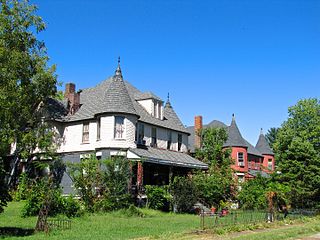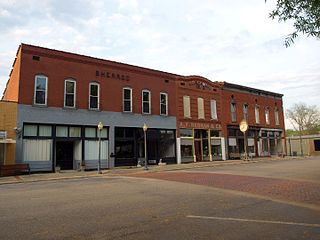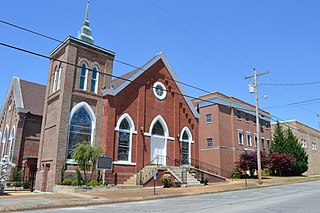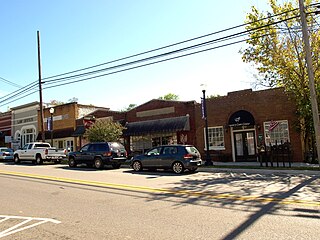The Seth Lore and Irwinton Historic District is a historic district in Eufaula, Barbour County, Alabama. It was listed on the National Register of Historic Places in 1986 as Lore Historic District; the registration document identified and described 72 specific buildings. And then its boundaries were increased and the district was renamed to "Seth Lore and Irwinton Historic District" in 19__; the entire area then contained 738 contributing buildings.

The Port Townsend Historic District is a National Historic Landmark District encompassing a significant portion of the waterfront and downtown area of Port Townsend, Washington. This area has many well-preserved late 19th-century buildings, owing to a building boom and crash in the 1880s. The result is one of the finest examples of a late 19th-century port town on the west coast. The historic district was listed on the National Register of Historic Places in 1976, and was designated a National Historic Landmark in 1977.

The W. B. Davis Hosiery Mill is a historic industrial complex in Fort Payne, Alabama. It opened in 1884 in the midst of Fort Payne's economic boom, manufacturing building hardware and supplies. The main building, which features Colonial Revival details, is three stories tall, with 12-over-12 sash windows on each floor. An 85-foot (26-meter) chimney has a flared top and corbeled brick course, imitating a doric order column. By 1890, hopes that large quantities of iron ore and other minerals would be discovered in the Fort Payne district proved to be ill-founded. The ABHMC and seven of Fort Payne's other large manufacturers merged in an effort to remain in business, but they were unable to avoid bankruptcy.

The Madison Station Historic District is a historic district in Madison, Alabama. Madison was first settled around 1818 as a farming community, but significant growth began in 1858, when the first depot was built along the Memphis and Charleston Railroad line. Madison Station became an important loading point for the shipment of cotton, supplanting the Tennessee River as the preferred means of shipment. Merchants and other businesses soon followed, with many people moving from the river port of Triana. After a lull during the Civil War, the town's growth continued; Madison was incorporated in 1869. The town grew steadily until the 1950s, when industry spurred by the expansion of Redstone Arsenal replaced cotton as the primary economic force in Madison County.

The Fort Payne Depot Museum is a historic building in Fort Payne, Alabama. The depot was built by the Alabama Great Southern Railroad in 1891, at the height of Fort Payne's mining-driven boom. Passenger service ended in 1970, but the depot continued to service freight until 1983. It was converted into a museum in 1986, which includes exhibits with 19th century and Native American artifacts, a collection of dioramas of fantasy scenes and historical events, and a former Norfolk Southern caboose. The depot was designed in Richardsonian Romanesque style by architect Charles C. Taylor. It is clad in grey sandstone with pink granite trim. The hipped roof has several gables protruding from it, as well as a circular tower on one corner. The depot was listed on the National Register of Historic Places in 1971.
The Collinsville Historic District is a historic district in Collinsville, Alabama. After the Cherokee were removed in 1835, Collinsville was founded on land owned by Alfred Collins, a settler from Rhea County, Tennessee. By 1848, he held title to over 680 acres. In 1852, construction began on the Wills Valley Railroad, running through Collinsville between Chattanooga, and Elyton ; the company was renamed to the Alabama Great Southern Railroad in 1877. The town began to grow, and was incorporated in 1887. Two fires in 1884 and 1900 destroyed most of the commercial buildings, and floods also plagued the town; a levee on Little Wills Creek was constructed in 1937 by the Works Progress Administration. The historic district is primarily residential with the remainder commercial, as well as two churches, a garage, two industrial buildings, three bridges, and the levee. Commercial buildings are mostly built in simple, commercial styles, and nearly all date from after the 1900 fire. Notable is the Art Moderne Cricket Theatre, built in 1946. The majority of houses date from 1891 through 1930, many of which are Queen Anne and Late Victorian, American Craftsman, and Vernacular styles. The district was listed on the National Register of Historic Places in 2006.

The Fort Payne Main Street Historic District is a historic district in Fort Payne, Alabama. Centered on the intersection of Gault Avenue and 1st Street, the district contains commercial and public buildings that date from Fort Payne's second period of growth from the 1920s to World War II. Buildings from the first wave of development in the 1880s and 1890s are centered in the Fort Payne Boom Town Historic District to the northeast. Most of the commercial buildings are in a simple, utilitarian brick style. The later civic buildings exhibit more decorated styles, including the Classical Revival Post Office, and the Art Moderne City Hall (1941) and DeKalb County Activities Building (1941). The district was listed on the National Register of Historic Places in 1989.

The Fort Payne Residential Historic District is a historic district in Fort Payne, Alabama. The district represents both of Fort Payne's major periods of growth: the 1880s and 1890s, fueled by the area's mineral deposits; and the 1910s through the 1930s, bolstered by the development of the hosiery industry. The area was predominantly middle class, meaning only a few Queen Anne homes were built; most houses from the early period were built in more restrained Vernacular Victorian styles. Later construction is dominated by American Foursquares and Craftsman Bungalows. The district was listed on the National Register of Historic Places in 1988.

The Attalla Downtown Historic District is a historic district in Attalla, Alabama. The city was founded in 1870 along the Alabama and Chattanooga Railroad. It quickly developed into a major iron ore export hub. After fires in 1887 and 1891, most of the frame buildings downtown were replaced with brick structures. The oldest buildings in the district, which date from the 1880s and 1890s, are built in Folk Victorian styles, with corbelled cornices and other decorative elements. Later buildings are in more plain Commercial Brick styles, while others were built in more academic styles, including the Art Moderne Etowah Theatre and the Colonial Revival Post Office building. The district was listed on the Alabama Register of Landmarks and Heritage in 2011 and the National Register of Historic Places in 2013.

The Bridgeport Historic District is a historic district in Bridgeport, Alabama. Founded in the 1810s as a farming community, Bridgeport became a major transportation hub with the coming of the Nashville and Chattanooga Railroad and Southern Railway in the 1850s, in addition to its Tennessee River port. Due to the importance of its rail bridge, the town changed hands several times during the course of the Civil War. Industry began to move into the area in the late 1880s and 1890s, and commercial development of the downtown area soon followed. The district retains several one- and two-story commercial buildings, most constructed out of brick in simple styles popular in the late 19th and early 20th centuries. Many of the elite built their homes on Battery Hill, overlooking the river. The district contains several Victorian and Queen Anne houses, as well as Bungalows and Vernacular styles. The Mission Revival Nashville, Chattanooga, and St. Louis Railroad depot, three railroad bridges, and three Civil War fortifications are also contained in the district. The district was listed on the National Register of Historic Places in 2002.

The Public Square Historic District is a historic district in Scottsboro, Alabama. Although Scottsboro had been the county seat of Jackson County since 1870, the town's earliest commercial development was centered on the Memphis and Charleston Railroad line, one block north of the square. After an 1881 fire along the rail line, some businesses began to rebuild around the square. Once the Tennessee Valley Authority brought prosperity to the region in the 1930s, development around the courthouse began to accelerate. The current Jackson County Courthouse was built in 1912 with matching Classical Revival porticos on two sides. Commercial buildings around the square are one or two stories and all of brick. While most are built in simple, lightly decorated commercial styles, some late 19th-century buildings have Victorian detailing. The district was listed on the Alabama Register of Landmarks and Heritage in 1981 and the National Register of Historic Places in 1982.

The Hartselle Downtown Commercial Historic District is a historic district in Hartselle, Alabama. The town was founded in 1870 when the Louisville and Nashville Railroad was extended south to Birmingham and Mobile. Hartselle quickly grew into a transportation hub for shipping timber and cotton. The town was devastated by two fires, in 1901 which destroyed all commercial buildings east of the railroad tracks, and in 1916 where twenty-one buildings including the passenger and freight depots were destroyed. Only nine buildings survived the 1916 fire. After an initial building boom from 1916 through 1920, development slowed due to low farming prices after World War I and the Great Depression. Notable structures in the district are the hip roofed L&N passenger depot and two-story freight depot and the Colonial Revival post office. Of the commercial buildings, 51 are one story, 14 are two stories, and 1 is three stories. The district was listed on the National Register of Historic Places in 1999.

The New Decatur–Albany Historic District is a historic district in Decatur, Alabama. The district encompasses the commercial district of the former town of New Decatur. It lies south of the Bank Street-Old Decatur Historic District and east of the New Decatur–Albany Residential Historic District. New Decatur was founded in 1887 as a planned town and suburb of Decatur. The town was renamed Albany in 1916 and merged with "Old" Decatur in 1927.

The Athens Courthouse Square Commercial Historic District is a historic district in Athens, Alabama. Athens was founded in 1818 when Robert Beaty and John D. Carroll began selling tracts of land. The following year, the town was chosen as the county seat of the newly formed Limestone County. Commercial development around the courthouse square was swift, aided by the strong cotton market. The town and courthouse suffered heavy damage during the Civil War in the Battle of Sulphur Creek Trestle. Athens' revival was slowed by major fires in 1882, 1894, and 1897, as well as the Panic of 1893. Redevelopment was spurred again in the 1910s and 1920s by a diversified economy with increased manufacturing, and in the 1930s by electricity provided by the Tennessee Valley Authority. Notable buildings in the district are the Limestone County Courthouse, built in 1919 in Neoclassical style with Palladian influences. The Old Post Office building was completed in 1933. The district was listed on the National Register of Historic Places in 1997 and the Alabama Register of Landmarks and Heritage in 2012.

The Courtland Historic District is a historic district in Courtland, Alabama. Courtland was founded in 1818 and incorporated the following year. Its location was chosen to be close to the Tennessee River to facilitate transportation, but also close to cotton plantations to the south. The town's founders envisioned becoming the county seat of the newly formed Lawrence County, but the title instead went to Moulton. Many of the earliest structures in Courtland were built of logs, and were later replaced with frame and brick buildings. Development plateaued by 1830, but received a slight bump from the Tuscumbia, Courtland and Decatur Railroad beginning in 1834. The oldest houses in the district date from this era, including the 1828 Federal-style John McMahon House and several I-houses.

The Ice House is a historic commercial building in Moulton, Alabama. It was built in 1946 at the beginning of Moulton's post-World War II boom period. After the town's previous ice house on the courthouse square was demolished to make way for new construction, R. W. Carter built a new ice house one block from the square with state-of-the-art ice making equipment. The ice house operated until 1977, serving homes and businesses in and around Moulton, as well as customers including Legion Field in Birmingham and the Browns Ferry Nuclear Power Plant across the Tennessee River. Today, the building houses an antique store, but the icemaking equipment is still intact. The building is a one-story, concrete block structure with a parapet roof. The façade has three original wood doors which originally enclosed the ice storage rooms, an entry door, and a window, all under a flat canopy. An office with two windows also projects from the façade. A concrete block residence constructed at the same time as the ice house sits behind the structure. The building was listed on the National Register of Historic Places in 2000.

The Wood Avenue Historic District is a historic district in Florence, Alabama. The residential neighborhood was primarily developed after Reconstruction, although five houses date from before the Civil War. By the time of Florence's economic boom of the 1880s, the most fashionable upper-class neighborhood in Florence, today known as the Sannoner Historic District, had already been filled in, leading development to move to Wood Avenue to the west. Most homes built during this time were large, Victorian structures, including many elaborate examples of Queen Anne architecture.

The Tuscumbia Historic District is a historic district in Tuscumbia, Alabama. The district contains 461 contributing properties and covers about 232 acres of the town's original area. The first white settlers in Tuscumbia built a village next to Big Spring, at the site of what is today Spring Park. Many settlers, many from Virginia and Maryland, began to emigrate to The Shoals in the 1820s and 1830s. The oldest houses in the district are Tidewater-type cottages, a style native to the Middle Atlantic. Also built during the town's early period are some of the oldest commercial buildings in Alabama, including the Morgan-Donilan Building and a seven-building block known as Commercial Row. The town's economy declined in the 1840s, when many farmers left seeking more fertile soil, through the Civil War and Reconstruction.

The Springville Historic District is a historic district in Springville, Alabama. The area around the "Big Spring" remained sparsely populated from 1814, when the land was ceded to the United States by the Creek Nation, until after the Civil War. A post office was established in 1834, and a sawmill was founded in 1861, but development did not begin in earnest until the coming of the Alabama and Chattanooga Railroad in 1870. Now connected to Atlanta and Columbus, Mississippi, business and industry began to center in Springville, and the town was a center for moving ore from the surrounding hills to industrial centers in Birmingham and Tuscaloosa.





















